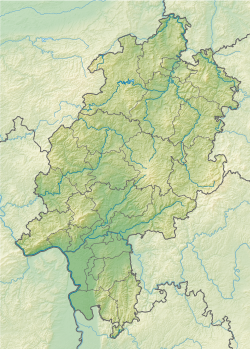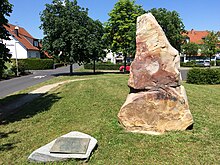Hünstein von Großenritte
| Hünstein von Großenritte | ||
|---|---|---|
|
The Hünstein von Großenritte |
||
|
|
||
| Coordinates | 51 ° 15 '4.3 " N , 9 ° 23' 46.8" E | |
| place | Baunatal , OT Großenritte , Hesse , Germany | |
| Emergence | Neolithic ? | |
The Hünstein von Großenritte in the Baunatal district of Großenritte is a cultural monument in northern Hesse . The menhir of quartzite was v the center of a ritual gathering place from the 4th to 3rd millennium. Chr.
history
Until 1911 the stone was in an open field near Großenritte. Then it was sunk in the ground by the owner of the field.
The menhir was rediscovered in 1932 by Herbert Bohley and excavated by his student Wilhelm Jordan on behalf of the Hessian state archaeologist Gero von Merhart . He set up the menhir again not far from the site. Today the menhir is on the Hünsteinplatz in Großenritte.
On the Hünstein there is also a memorial plaque to August Boley, who found the Hünstein. It bears the inscription:
Born May 12, 1894 in Riede
One of the many merits that August Boley had as a pedagogue, local history researcher, monument conservator, nature conservation officer, ornithologist and adult educator is the recovery and erection of the Hünstein, which was sunk a long time ago on the Opfertriesch, in 1936. The menhir was found as part of the planning of this new development area Valuable cultural monument of the Neolithic age the current location and reminds of its finder August Boley.
Dimensions
The stone is 2.5 m high. It tapers conically from a diameter of 1.3 m at the bottom to the top.
Finds
Prehistoric shards, an amber bead and a fragment of a stone ax were found near the menhir .
legend
A giant is said to have torn the menhir from the nearby Hirzstein near Elgershausen in Habichtswald in order to smash the church tower of Kirchbauna. The block slipped out of his hand too early, flew only an hour and fell in large rides on the farmland. The giant's five fingerprints can still be seen on the stone.
literature
- Johannes Groht : Menhirs in Germany. State Office for Monument Preservation and Archeology Saxony-Anhalt, Halle (Saale) 2013, ISBN 978-3-943904-18-5 , p. 150.
- Fritz-Rudolf Herrmann , Albrecht Jockenhövel : The prehistory of Hesse . Theiss, Stuttgart 1990, ISBN 3-8062-0458-6 , p. 322.
- Irene Kappel: Stone chamber graves and menhirs in Northern Hesse. Staatliche Kunstsammlungen, Kassel 1978, pp. 65–66 ( Guide to North Hessian Prehistory and Early History 5).
- Horst Kirchner: The menhirs in Central Europe and the menhir thought (= Academy of Sciences and Literature. Treatises of the humanities and social sciences class. Born 1955, No. 9). Wiesbaden 1955, p. 171.
- Luthmer: Small messages. In: Germania. Volume 16, 1932, p. 316.
Web links
- grosssteingraeber.de: Hünstein
- The Megalithic Portal: Hünstein Great Rides


